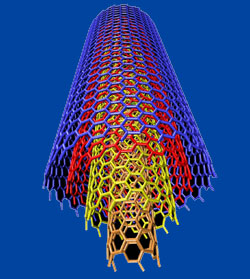An aggregate of carbon nanotubes coated with a thin layer of a protein-recognizing polymer is a new biosensor capable of detecting minute amounts of proteins

An aggregate of carbon nanotubes coated with a thin layer of a protein-identifying polymer constitutes a new biosensor capable of detecting minute amounts of proteins using electrochemical signals. The findings, published in the scientific journal Nature Nanotechnology by a team of researchers from Boston University, could provide a new essential diagnostic tool for detecting a variety of diseases.
The nanotube-based biosensor demonstrated its ability to detect ferritin (ferritin, a human protein), which is the main protein in iron storage cells, and also to detect the E7 protein derived from the human papillomavirus. Additional experiments, conducted by an interdisciplinary team of biologists, chemists and physicists, with the protein calmodulin (calcium-binding protein, calmodulin) showed that the sensor is able to differentiate even between the different forms of the protein.
Molecular imprinting methods have shown that polymeric structures can contribute to the development of sensors capable of identifying defined organic compounds, however the identification of proteins has been a more difficult challenge. The team of scientists from Boston University used wire-fence-like nanotubes coated with an insulating polymer capable of "sensing" proteins at a sensitivity level of sub-picograms per liter.
One of the key features of the sensors is the embedding of protein particles within the insulating polymer coating. Since the rings reduce the thickness of the coating layer, these complexes in the polymer exhibit a lower level of electrical resistance than the other areas of the polymer when interacting with the electrical charges found in the proteins and the ionized salt solution. When the protein fragment "falls" into the interior of its mirror template in the polymer, it fills it and causes the nanotube to exhibit a significant change in resistance, which signals the presence of protein.
The discovery can be made in real time, instead of after days or weeks of laboratory tests, that is - the method of molecular imprinting of nanotubes may pave the way for the development of biosensors capable of detecting human viruses (such as the papilloma virus) weeks earlier than the currently available diagnostic methods. In contrast to diagnostic methods that try to detect the antibody of the virus or discover immune responses following the initial infection with the virus, the nanotube sensor is able to detect the protein of the virus itself. In addition, in this electrochemical detection method there is no need to add chemical markers.
"In the case of certain diseases, no one really knows why that person is sick," says the lead researcher. "All we know is that the disease may have been caused by the presence of a virus. At this point in time, the patient may not have measurable amounts of antibodies in the blood at all. That is, precisely at the time when it is essential to get an accurate diagnosis, there may be no traces of the virus at all. Basically, as a result, we lost our opportunity. Now we are able to identify cell envelope proteins of the virus itself through molecular imprinting and perform the test."

One response
Interesting article.
Thanks